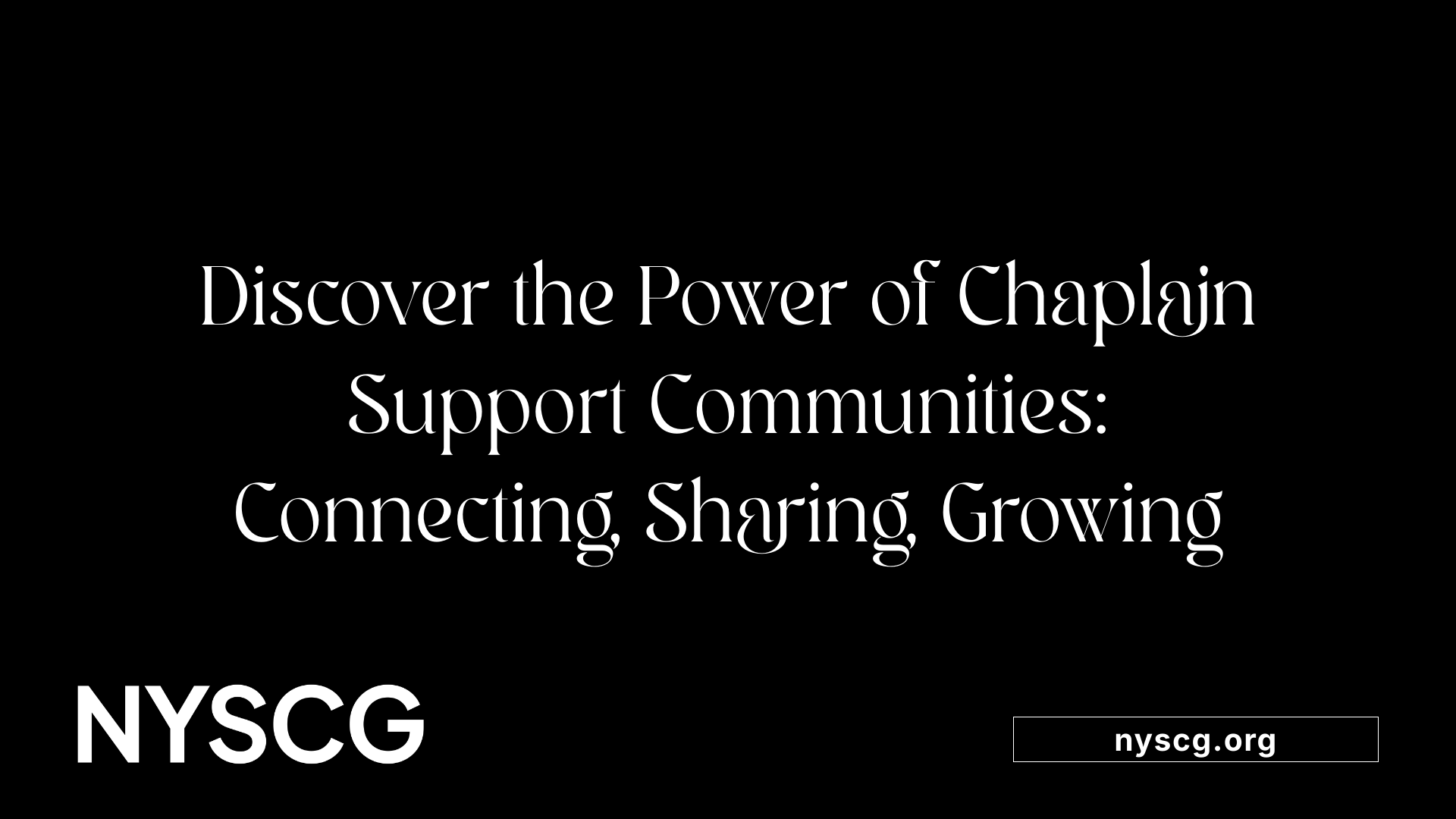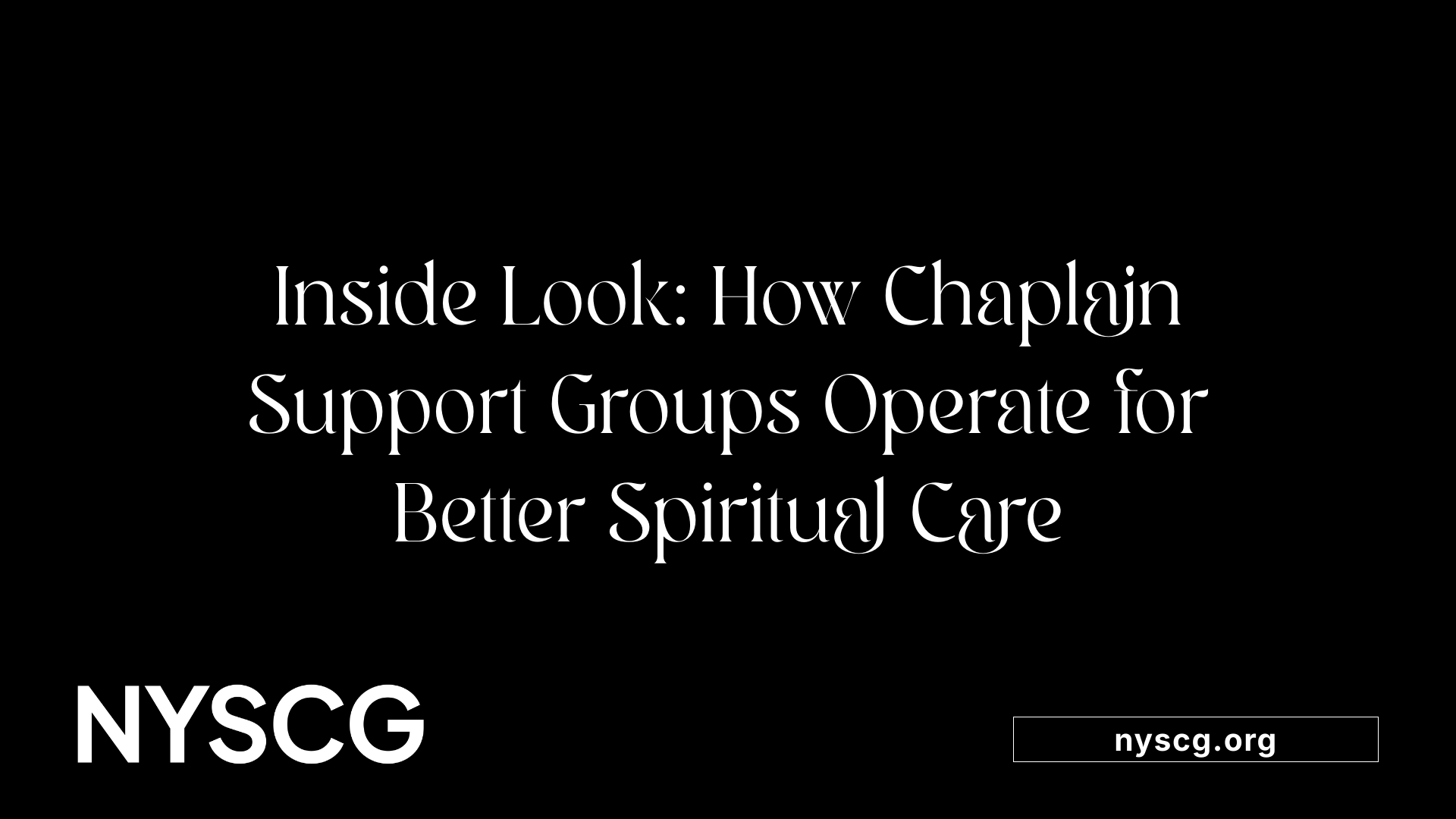Are There Chaplain Support Groups or Communities?


Chaplain support groups and communities are vital networks that foster professional collaboration, spiritual growth, and emotional resilience among caregiving professionals. They exist across various settings, including hospitals, military, correctional facilities, and community organizations, providing a platform for shared learning, mutual support, and ongoing development. This article delves into the structure, purpose, operation, and benefits of these communities, highlighting their indispensable role in enhancing spiritual care and supporting the well-being of both chaplains and the communities they serve.

Chaplain support groups or communities are organized networks of spiritual care providers who regularly meet—typically online—to connect, share experiences, and support one another. These groups usually consist of around 12 members, often formed based on geographic or specialty service areas.
The main goal of these communities is to foster peer support and mentorship. They provide a platform where chaplains can discuss challenges, exchange insights, and develop professionally. Regular meetings, often held monthly via Zoom for about an hour, allow members to maintain ongoing contact. Quarterly, they may hold longer sessions dedicated to deeper discussions and peer learning.
Beyond individual development, communities encompass diverse backgrounds, religious traditions, and settings, promoting inclusivity and cultural sensitivity. They emphasize evidence-based practices, ensuring that spiritual care is effective, respectful, and ethically grounded.
By encouraging mutual accountability and supervision, these groups help chaplains refine their skills and stay current with continuing education requirements. As a result, they bolster the capacity of chaplains to provide holistic, compassionate care to individuals across various institutions—such as hospitals, jails, military, and community organizations.
Overall, chaplain support communities are vital for nurturing the ongoing growth and resilience of spiritual caregivers. They strengthen professional bonds, uphold standards of excellence, and ultimately enhance the quality of spiritual, emotional, and mental support delivered to the communities served.

Chaplain support communities function as structured, collaborative groups that meet regularly to foster professional growth and mutual support among spiritual caregivers. These communities, typically comprising about 12 members, convene monthly via Zoom, with each session lasting between 60 to 90 minutes. In addition, they may host quarterly longer meetings dedicated to in-depth discussions and peer learning.
Organized mainly by geographic regions to reflect shared local cultural, religious, and social contexts, these groups encourage open dialogue on challenges and best practices in chaplaincy. Membership is open to any member of the Spiritual Care Association, regardless of certification or experience level, emphasizing inclusivity and diversity.
Each group usually features a designated moderator or facilitator, with rotating members assisting in guiding conversations. These discussions often include peer support, mentoring, and opportunities for professional and spiritual development. Participation allows members to earn continuing education units (CEUs), contributing to their ongoing certification requirements.
Beyond individual member growth, these communities serve to strengthen the broader field of spiritual care by sharing evidence-based practices and experiences across various settings—such as hospitals, correctional facilities, disaster zones, and community outreach programs. They aim to provide a safe, supportive environment where chaplains can collaborate, exchange ideas, and enhance their capacity to serve those in need during times of crisis or routine care.
In summary, these communities operate as vital networks that promote ongoing learning, emotional resilience, and connection among chaplains, ensuring they are well-equipped to deliver compassionate spiritual support across diverse environments.

Chaplains interested in becoming involved in support communities generally start by joining established professional organizations dedicated to chaplaincy and spiritual care. These organizations often host local and national networks that encourage peer-to-peer support, resource sharing, and ongoing education.
One prominent way to engage is through online platforms tailored for spiritual caregivers. These digital spaces facilitate discussions, provide updates on best practices, and promote collaboration among members, regardless of geographic location.
In addition to national networks, many chaplains connect through local hospital chaplaincy programs or healthcare teams. Participating in interdisciplinary teams allows chaplains to contribute to staff training, participate in ethics committees, and influence policies affecting spiritual care.
Attending conferences, workshops, and seminars is another effective pathway. These events foster networking opportunities, enhance professional development, and enable chaplains to learn from peers and experts in the field.
Joining community support groups such as those organized by the Spiritual Care Association or regional chaplaincy bodies often requires simply reaching out via email or online registration. For example, chaplains can contact coordinators like Chaplain David Pascoe for details about membership and involvement.
Participation in these communities also helps chaplains develop a shared sense of professional identity, advocate for spiritual care within the broader health services, and stay current with evidence-based practices.
PathwayDescriptionBenefitsMembership in professional organizationsJoin networks like the Spiritual Care AssociationPeer support, resources, credentialsOnline forums and platformsParticipate in dedicated digital communitiesContinuous learning, collaborationLocal hospital or community programsEngage in hospital teams or community outreachPractical experience, networkingConferences and workshopsAttend training events and seminarsSkill enhancement, industry awareness
Engaging actively in these ways ensures spiritual caregivers remain connected, supported, and effective in their vital roles.

Training and credentials are vital components that help ensure chaplains are well-prepared to support their communities effectively. Formal training programs, such as those provided by the Church of God Chaplains Commission or through clinical pastoral education (CPE), equip chaplains with a broad skill set. These include pastoral counseling, crisis response, ethics, and interfaith practices.
Credentials like certifications, licenses, and ordination serve to validate the chaplain’s qualifications and authority to engage professionally in various settings. For example, chaplains working in hospitals, veterans’ facilities, or disaster zones often require specific certifications to operate confidently and legally.
Having recognized training and formal credentials fosters trust among community members, colleagues, and organizations. It also facilitates professional collaboration, enabling chaplains to participate in multidisciplinary teams, support networks, and continuing education initiatives.
Overall, these qualifications uphold standards of practice, enhance competency, and encourage active engagement within community and organizational support systems.

Chaplain support groups and communities serve as vital platforms to enhance spiritual care and professional growth among chaplains. These networks, typically composed of around 12 members, meet regularly to foster peer support, mentorship, and mutual accountability. They provide a space where chaplains can share resources, discuss challenges, and uphold ethical standards, ultimately improving the quality of care delivered across settings such as hospitals, correctional facilities, faith-based organizations, and community services.
Regular meetings—held monthly via Zoom and often lasting 60 to 90 minutes—allow participants to connect, reflect, and develop their skills. During these sessions, chaplains engage in professional and spiritual development, participate in continuing education units (CEUs), and exchange best practices that support evidence-based approaches.
The community’s main aim is to promote holistic support, addressing the emotional, spiritual, and professional needs of chaplains. Through these connections, members build a sense of belonging and shared purpose that sustains them in their demanding roles.
Moreover, these groups advocate for the importance of spiritual care within broader healthcare and community systems. They help reduce professional isolation, bolster resilience, and foster cultural and interfaith understanding by supporting diverse backgrounds and spiritual traditions.
Overall, chaplain communities are designed to elevate the practice of spiritual care—making it more accessible, ethical, and effective—while also nurturing the well-being of those who provide it. The collective goal is to sustain high standards of service, improve patient and community outcomes, and support the personal and spiritual growth of chaplains.
Chaplain support groups and communities play a crucial role in enhancing the quality, accessibility, and cultural competency of spiritual care. Through regular meetings, shared resources, and professional development opportunities, they empower chaplains to serve more effectively across diverse settings. These networks also foster a sense of belonging and mutual learning, helping spiritual caregivers navigate the challenges of their roles with confidence and resilience. As the landscape of health care and community needs evolves, the ongoing growth and strengthening of chaplain communities will remain essential to providing compassionate, holistic care that respects individual beliefs, promotes well-being, and upholds the highest standards of professional practice.
All you need is the will to make the world a better place.
New York State chaplain group inc. is a tax deductible organization with a federal tax Id number 92-383-4921